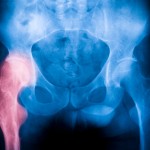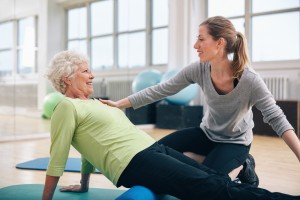
Last week we looked at the evidence for exercises in water (hydrotherapy or therapeutic aquatic exercise) for osteoarthritis of the hip and knee.
This week we found examining whether land-based therapeutic exercise is beneficial for people with hip osteoarthritis in terms of reduced joint pain and improved physical function and quality of life.
Here’s what they did
The authors searched five databases from inception up to February 2013 for randomised controlled trials (RCTs) recruiting people with hip OA and comparing some form of land-based therapeutic exercise with a non-exercise group.
Review authors independently selected studies for inclusion and extracted data, assessed risk of bias and the quality of the body of evidence for each outcome using the GRADE approach.
They reported effect sizes as standardised mean differences (SMD) and 95% confidence intervals.
Here’s what they found
- They included 10 RCTs (549 participants), seven had a low risk of bias, only three small studies (183 participants) evaluated quality of life.
- Participants with mostly mild-to-moderate symptomatic hip OA, alone or with knee OA.
- Except for one study where participants enrolled in a tai chi programme, all other participants underwent land-based exercise programmes consisting of traditional muscle strengthening, functional training and aerobic fitness programmes, either individually supervised or as part of a group, compared with people who did not exercise.
- Pain
- exercise reduced pain (SMD – 0.38, 95% CI -0.55 to -0.20), high-quality evidence from nine trials (549 participants)
- exercise reduced pain by an equivalent of 8 points on a scale 0-100 (95%CI 4 to 11 points; number needed to treat for an additional beneficial outcome (NNTB = 6)
- Physical function
- improved (SMD -0.38, 95% CI -0.54 to -0.05) by an equivalent of 7 points on a 0-100 scale (95%CI 1 to 12 points; NNTB = 6)
- Quality of life
- no benefit demonstrated (SMD -0.07, 95% CI -0.23 to 0.36)
- exercise improved quality of life by 0 points on a 0-50 scale.
- Withdrawal from exercise
- Moderate quality evidence from seven trials (715 participants) indicated an increased likelihood of withdrawal from the exercise allocation (event rate 6%) compared with the control group (event rate 3%), but this difference was not significant (risk difference 1%; 95% CI -1% to 4%).
- Adverse events
- Of the five studies reporting adverse events, each study reported only one or two events and all were related to increased pain attributed to the exercise programme.
The authors concluded
Land-based therapeutic exercise programmes can reduce pain and improve physical function among people with symptomatic hip OA.

Exercise can reduce pain and improve physical function among people with hip osteoarthritis
The Musculoskeletal Elf’s view

It appears from the results of this review that land based exercise is beneficial for osteoarthritis of the hip for both pain and function. But the authors also report the numbers need to benefit (NNTB) as being 6 for both pain and fuction. What does this mean? Well, for every 6 people who exercise, one will have beneficial effects.
However, we must also remember that regular moderate intensity physical activity – such as walking, cycling, or participating in sports – has been shown to have significant benefits for health. It can reduce the risk of cardiovascular diseases, diabetes, colon and breast cancer, and depression and decrease the risk of a hip or vertebral fracture and help control weight.
Please watch this excellent short video by Doc Mike Evans ’23 1/5 hours: the single best thing you can do for your health’.
What do you think?
- How effective do you find exercise for OA hip?
- Do you find that exercise reduces pain in the hip?
- Do you find that exercise improves physical function?
- Does exercise have an effect on quality of life?
Send us your views on this blog and become part of the ever expanding Musculoskeletal Elf community. Post your comment below, or get in touch via social media (Facebook, Twitter, LinkedIn, Google+).
Links
- Fransen M, McConnell S, Hernandez-Molina G, Reichenbach S. Exercise for osteoarthritis of the hip. Cochrane Database of Systematic Reviews 2014, Issue 4. Art. No.: CD007912. DOI: 10.1002/14651858.CD007912.pub2. [Abstract]
- Doc Mike Evans, 23 1/5 hours the single best thing you can do for your health.

RT @MSK_Elf: Is exercise effective for osteoarthritis of the hip for pain and function? http://t.co/fDz3KgK0Bn
Is #exercise effective for #osteoarthritis #hip for #pain and #function? http://t.co/rl3TglwHxf @ArthritisCareSC @Arthritis_care
this is the way to present knowledge http://t.co/HgRpOOJqvW well done as always Elfie @MSK_Elf
RT @ProfTraceyHowe: Is #exercise effective for #osteoarthritis #hip for #pain and #function? http://t.co/t08pllO5mj @ArthritisCareSC @Arthr…
#osteoarthritis #hip #pain reduced #function? Is #exercise effective http://t.co/t08pllO5mj @PTHSN @arthritisFdn
@GCUPhysio @thecspstudent is #exercise effective #osteoarthritis #hip #pain #function http://t.co/t08pllO5mj
@LindAlliance @sally_crowe is #exercise effective #osteoarthritis #hip #pain #function? http://t.co/UfNqEVPclo
Q. How effective do you find #exercise for #osteoarthritis #hip #pain #function? http://t.co/UfNqEVPclo @PhysioMACP @PhysioPainAssoc
How effective is exercise for OA of hip for pain and function?
http://t.co/4GJZYfkdUQ
RT @MSK_Elf: Q. How effective do you find #exercise for #osteoarthritis #hip #pain #function? http://t.co/rl3TglwHxf @PhysioMACP @PhysioPai…
Does #exercise for #osteoarthritis #hip improve #pain #function http://t.co/UfNqEVPclo @mgtmccartney @RCGP
Q. How effective do you find #exercise for #osteoarthritis #hip #pain #function? http://t.co/UfNqEVPclo @CochranConsumer @CochraneMSK
RT @MSK_Elf: Q. How effective do you find #exercise for #osteoarthritis #hip #pain #function? http://t.co/rl3TglwHxf @CochranConsumer @Coch…
http://t.co/ObsivxT3IQ
Exercise for #osteoarthritis of the hip. A great review of the science by @MSK_Elf http://t.co/4te0M2jQ66
RT @felly500: Is exercise effective for osteoarthritis of the hip for pain and function?
yes.
http://t.co/UlxzwXiJB0
Excellent resource RT@felly500: Is exercise effective for osteoarthritis of the hip for pain and function?
yes.
http://t.co/j1ea9NIddG”
Check this out – really good:RT “@MSK_Elf: Is #exercise effective for #osteoarthritis #hip for #pain and #function? http://t.co/i8gUbS0Ive”
Is exercise effective for osteoarthritis of the hip for pain and function? http://t.co/JoNY0mvFL4 via @sharethis